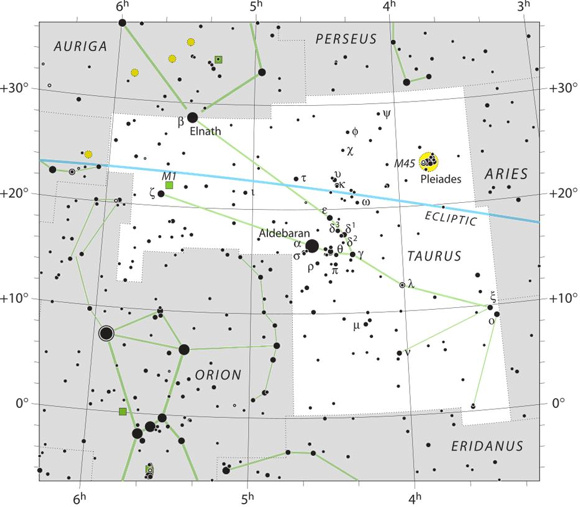
Moon sweeps by Taurus
As the moon orbits Earth, a waning crescent moon appears in the early morning sky every month. And it sweeps past whatever bright stars and planets happen to be in that part of the sky. Unless you’re a night owl, you won’t see the moon and constellation Taurus the Bull ascending in the east before your bedtime. But you will see them before the beginning of astronomical twilight on August 2, 3 and 4, 2021. On these mornings, the moon and stars of Taurus will climb highest up just before daybreak.
The chart at top is designed for mid-northern North American latitudes. But the moon will be passing in front of Taurus on these dates as seen from around the world. Before dawn in the world’s Eastern Hemisphere – Europe, Africa, Asia, Australia and New Zealand – look for the moon to be offset toward the previous date. The farther east you live, the greater the offset.
On the morning of August 2, the moon will pass to the south of the Pleiades star cluster. The following day, August 3, will find the moon sweeping to the north of Aldebaran, the brightest star in Taurus. Aldebaran is a bright red star, part of a V-shaped pattern that represents the Bull’s Face. Red Aldebaran represents the Bull’s fiery Eye.
Visit Sunrise Sunset Calendars to find out when dawn’s first light (astronomical twilight) begins in your sky. Be sure to check the Astronomical Twilight box.
Moon travels ever-eastward
The lit side of a waning moon always points eastward. And eastward also happens to be the moon’s direction of travel through the constellations of the zodiac. Relative to the backdrop stars, the moon travels eastward at the rate of about 1/2 degree (about the moon’s own angular diameter) per hour.
Hence, from around the world, the moon will appear closer to the star Aldebaran on August 3 than on August 2. This change in the moon’s position in our sky is due to its motion in orbit around Earth.
Aldebaran, the star depicting the Eye of the Bull, crowns a V-shaped pattern of stars that outlines the Bull’s Face. Extend this starlit V upwards to Elnath, the second-brightest star in Taurus. Elnath marks the tip of the Bull’s northern Horn. The fainter star at the tip of the Bull’s southern Horn is Zeta Tauri. This 3rd-magnitude star, though rather faint, is easy to see on a dark, moonless night.

When the moon occults the Pleiades
Month by month now, the moon is following follow a slightly more northerly trek in front of the Bull. Each month will find the moon swinging farther away from Aldebaran, and closer to the Pleiades. In fact, the moon will occult – cover over – Alcyone, the Pleiades’ brightest star, on September 5, 2023.
The monthly occultation series will continue until until July 7, 2029, to stage a total of 79 occultations. Of course, you have to be on the right spot on Earth to be able to witness any one of these occultations.
Bottom line: Let the waning crescent moon show you the constellation Taurus on August 2, 3 and 4, 2021.











